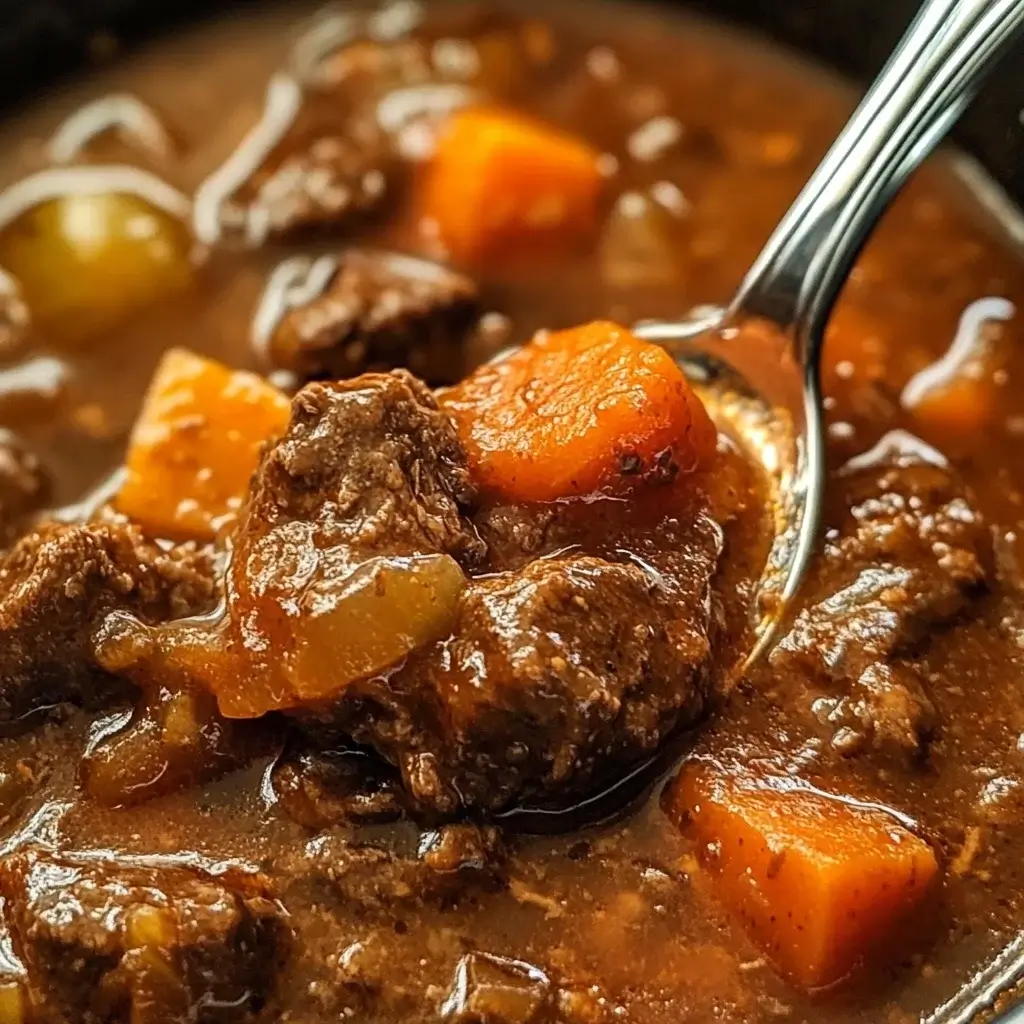There’s something undeniably comforting about walking into a home filled with the rich, savory aroma of beef stew simmering away. For my family, slow cooker beef stew has become a beloved staple, especially during the cooler months. It’s that dish that magically transforms simple ingredients into a deeply flavorful and satisfying meal with minimal effort. The beauty of it lies in its simplicity – just toss everything into the slow cooker, set it, and forget it. The result? Tender, melt-in-your-mouth beef and perfectly cooked vegetables swimming in a luscious, savory broth. Even my pickiest eater devours a bowl (or two!), and the leftovers are always a welcome treat the next day. This isn’t just a recipe; it’s a warm hug in a bowl, perfect for busy weeknights or cozy weekend dinners. Let me share my tried-and-true slow cooker beef stew recipe, along with all the tips and tricks I’ve learned over the years to make it absolutely perfect every single time. Get ready to experience the magic of slow cooking and create a meal that will become a family favorite for generations to come.
Ingredients
- Beef Chuck Roast (2 lbs): Choose a well-marbled chuck roast, cut into 1-inch cubes. Chuck roast is ideal for slow cooking as it becomes incredibly tender and flavorful as it breaks down.
- Yellow Onion (1 large): Roughly chopped. Onions form the aromatic base of the stew, adding depth and sweetness as they caramelize during the slow cooking process.
- Carrots (3-4 large): Peeled and cut into 1-inch chunks. Carrots provide sweetness and vibrant color to the stew, softening beautifully in the slow cooker.
- Celery (3-4 stalks): Cut into 1-inch pieces. Celery adds a subtle savory note and aromatic complexity to the stew.
- Potatoes (2 lbs): Yukon Gold or Russet, peeled and cut into 1-inch cubes. Potatoes become wonderfully creamy and absorb the rich flavors of the stew.
- Mushrooms (8 oz): Cremini or white button mushrooms, quartered or sliced if large. Mushrooms add an earthy umami flavor and meaty texture to the stew.
- Garlic (4 cloves): Minced. Garlic infuses the stew with its pungent aroma and savory depth.
- Tomato Paste (2 tablespoons): Concentrated tomato flavor that adds richness and depth to the broth.
- Beef Broth (4 cups): Low sodium beef broth forms the liquid base of the stew and enhances the beefy flavor.
- Red Wine (1 cup): Dry red wine like Cabernet Sauvignon or Merlot (optional, can substitute with more beef broth). Red wine adds complexity and depth of flavor to the stew.
- Worcestershire Sauce (2 tablespoons): Adds a savory umami depth and tanginess to the stew.
- Dried Thyme (1 teaspoon): Earthy and aromatic herb that complements beef and vegetables beautifully.
- Dried Rosemary (1 teaspoon): Piney and fragrant herb that adds a warm, comforting note to the stew.
- Bay Leaf (1): Adds a subtle, savory herbal note that enhances the overall flavor of the stew. Remember to remove it before serving.
- All-Purpose Flour (2 tablespoons): For thickening the stew (optional). Flour helps to create a richer, thicker broth.
- Olive Oil (2 tablespoons): For searing the beef and sautéing vegetables (optional but recommended for flavor).
- Salt and Black Pepper: To taste. Essential for seasoning and enhancing all the flavors in the stew.
- Fresh Parsley (for garnish): Chopped fresh parsley adds a bright, fresh finish to the stew.
Instructions
- Prepare the Beef (Optional but Highly Recommended for Flavor): Pat the beef chuck cubes dry with paper towels. Season generously with salt and black pepper. Heat olive oil in a large skillet or Dutch oven over medium-high heat. Working in batches to avoid overcrowding the pan, sear the beef cubes on all sides until nicely browned. Searing adds a rich, caramelized flavor to the beef and stew. Remove the seared beef from the skillet and set aside.
- Sauté Aromatics and Vegetables (Optional but Recommended for Flavor Depth): In the same skillet (no need to clean it), add the chopped onions and cook over medium heat until softened and translucent, about 5-7 minutes. Add the minced garlic, carrots, and celery to the skillet and cook for another 5-7 minutes, stirring occasionally, until the vegetables are slightly softened. Sautéing these vegetables before slow cooking helps to develop their flavors and adds another layer of depth to the stew.
- Combine Ingredients in the Slow Cooker: Transfer the sautéed vegetables (if sautéing) to a 6-quart or larger slow cooker. Add the seared beef (or raw beef if skipping searing) to the slow cooker. Add the potatoes, mushrooms, tomato paste, beef broth, red wine (if using), Worcestershire sauce, dried thyme, dried rosemary, and bay leaf. Stir everything together to combine, ensuring the beef and vegetables are mostly submerged in the liquid.
- Slow Cook the Stew: Cover the slow cooker and cook on low heat for 7-8 hours or on high heat for 3-4 hours, or until the beef is fork-tender and the vegetables are cooked through. Cooking time may vary slightly depending on your slow cooker model and the size of your beef cubes and vegetables. For the most tender beef, low and slow is recommended.
- Thicken the Stew (Optional): If you prefer a thicker stew, you can thicken it during the last 30 minutes of cooking time. In a small bowl, whisk together the all-purpose flour and a few tablespoons of hot liquid from the slow cooker until smooth. This creates a slurry. Gradually whisk the slurry back into the slow cooker, stirring to combine. Cover and continue to cook on high heat for another 20-30 minutes, or until the stew has thickened to your desired consistency. Alternatively, for a gluten-free option, you can use a cornstarch slurry (1 tablespoon cornstarch mixed with 2 tablespoons cold water) or simply let the stew simmer uncovered on high for the last 30-45 minutes to reduce and thicken naturally.
- Season and Serve: Once the stew is cooked and thickened (if desired), remove the bay leaf. Taste the stew and adjust seasoning with salt and black pepper as needed. Be generous with seasoning as slow cooking can sometimes mellow out flavors. Ladle the slow cooker beef stew into bowls. Garnish with fresh chopped parsley before serving. Serve hot and enjoy!
Nutrition Facts
(Per Serving, approximately 6 servings)
- Calories: Approximately 450-550 kcal (depending on serving size and specific ingredients)
- Protein: 35-40g
- Fat: 20-25g (Adjustable based on beef trim and oil usage)
- Iron: 3-4mg (Excellent source of iron)
Note: Nutritional values are estimates and can vary based on specific ingredients, brands, and serving sizes. For precise nutritional information, use a nutrition calculator with the specific ingredients you use.
Preparation Time
- Prep Time: 30-40 minutes (includes chopping vegetables and searing beef if opting for searing). While there’s some initial prep work, it’s mostly chopping vegetables and a quick sear for the beef.
- Cook Time: 7-8 hours on low or 3-4 hours on high in the slow cooker. The slow cooker does the majority of the work, allowing you to set it and forget it while you go about your day.
- Total Time: Approximately 7.5-8.5 hours (mostly hands-off slow cooking time). This recipe is perfect for busy individuals as it requires minimal active cooking time.
How to Serve
Slow cooker beef stew is a complete meal on its own, but here are some delicious ways to serve it and enhance your dining experience:
- With Crusty Bread: Serve with a side of crusty bread, baguette slices, or sourdough for dipping into the rich broth and soaking up every last drop of flavor.
- Over Mashed Potatoes: Spoon the hearty beef stew over creamy mashed potatoes for an extra comforting and satisfying meal. The stew broth melds beautifully with the mashed potatoes.
- With Rice or Quinoa: Serve over fluffy white rice, brown rice, or quinoa for a lighter option that still provides a satisfying base for the stew.
- Alongside a Green Salad: Balance the richness of the stew with a fresh and crisp green salad dressed with a vinaigrette. The salad adds a refreshing contrast.
- Topped with Sour Cream or Greek Yogurt: A dollop of sour cream or Greek yogurt adds a creamy tang and coolness to the warm stew, creating a delightful contrast in textures and flavors.
- Garnished with Fresh Herbs: Besides parsley, consider garnishing with fresh thyme sprigs, rosemary leaves, or chives for an extra layer of freshness and aroma.
- With Biscuits or Dumplings: For an even heartier meal, serve with homemade biscuits or drop dumplings cooked right in the slow cooker during the last hour of cooking.
Additional Tips for Perfect Slow Cooker Beef Stew
- Don’t Skip Searing the Beef (If You Have Time): Searing the beef before slow cooking is a game-changer for flavor. It creates a beautiful crust and locks in the juices, adding a depth of flavor that you won’t get by just adding raw beef to the slow cooker. Even a quick sear on a couple of sides makes a difference.
- Layer Flavors with Aromatics: Sautéing the onions, garlic, carrots, and celery before slow cooking adds another layer of flavor complexity. It softens the vegetables and releases their aromatic compounds, creating a richer base for the stew.
- Use Quality Beef Broth: The beef broth is a key component of the stew, so opt for a good quality, low-sodium beef broth. Homemade beef broth is even better if you have the time, but store-bought low-sodium broth is a convenient and flavorful option.
- Don’t Overcrowd the Slow Cooker: Avoid overfilling the slow cooker, as this can hinder even cooking and may result in a stew that takes longer to cook or doesn’t cook through properly. If you have a lot of ingredients, use a larger slow cooker or cook in batches.
- Adjust Vegetables to Your Preference: Feel free to customize the vegetables in your stew based on your preferences and what you have on hand. Other great additions include parsnips, turnips, sweet potatoes, or peas (add frozen peas in the last 30 minutes of cooking).
- Deglaze the Skillet for Extra Flavor (If Searing): After searing the beef, deglaze the skillet by pouring in the red wine (or a splash of beef broth) and scraping up any browned bits from the bottom of the pan. These browned bits (fond) are packed with flavor and will add extra depth to your stew. Add this flavorful liquid to the slow cooker.
- Don’t Overcook the Vegetables: Keep an eye on the vegetables towards the end of the cooking time. You want them to be tender but not mushy. If you find your vegetables are cooking too quickly, you can add them later in the cooking process, especially potatoes and carrots.
- Let it Rest Before Serving: Allow the slow cooker beef stew to rest for about 10-15 minutes after cooking before serving. This allows the flavors to meld together even further and the stew to thicken slightly.
FAQ – Frequently Asked Questions About Slow Cooker Beef Stew
Q1: Can I make this stew without red wine?
A: Yes, absolutely! If you prefer not to use red wine or don’t have any on hand, simply substitute it with an equal amount of beef broth. The red wine adds depth and complexity, but the stew will still be delicious without it. You could also add a splash of balsamic vinegar or Worcestershire sauce for a touch of acidity and depth.
Q2: Can I use a different cut of beef besides chuck roast?
A: While chuck roast is highly recommended for slow cooker beef stew due to its marbling and ability to become incredibly tender, you can use other cuts of beef. Brisket or short ribs are also good options as they are tougher cuts that benefit from long, slow cooking. Avoid leaner cuts like sirloin or round steak, as they can become dry and tough in the slow cooker.
Q3: Can I freeze leftover slow cooker beef stew?
A: Yes, slow cooker beef stew freezes beautifully! Allow the stew to cool completely, then transfer it to freezer-safe containers or freezer bags. Remove as much air as possible to prevent freezer burn. Stew can be frozen for up to 2-3 months. Thaw overnight in the refrigerator before reheating on the stovetop or in the microwave until heated through.
Q4: Can I make this stew on the stovetop instead of a slow cooker?
A: Yes, you can adapt this recipe for the stovetop. Follow the searing and sautéing steps as described. Then, combine all ingredients in a large Dutch oven or heavy-bottomed pot. Bring to a simmer, then reduce heat to low, cover, and simmer for 2-3 hours, or until the beef is fork-tender. Stir occasionally and ensure the stew doesn’t stick to the bottom of the pot.
Q5: How can I make my beef stew thicker without flour?
A: There are several ways to thicken beef stew without flour. You can use a cornstarch slurry (1 tablespoon cornstarch mixed with 2 tablespoons cold water) added in the last 30 minutes of cooking. Alternatively, you can mash some of the cooked potatoes against the side of the slow cooker to release their starch and thicken the stew naturally. You can also let the stew simmer uncovered on high heat for the last 30-45 minutes to reduce the liquid and thicken it.
Q6: Can I add different vegetables to my beef stew?
A: Absolutely! Beef stew is very versatile, and you can customize it with your favorite vegetables. Parsnips, turnips, rutabaga, sweet potatoes, butternut squash, green beans, peas, and corn are all great additions. Root vegetables like parsnips and turnips can be added at the beginning with the carrots and celery. Tender vegetables like peas and green beans should be added during the last 30-45 minutes of cooking to prevent them from becoming mushy.
Q7: My beef stew is bland. What can I do to add more flavor?
A: Bland stew can often be fixed with proper seasoning. Taste and adjust salt and pepper first. You can also add more depth of flavor by adding a splash more Worcestershire sauce, a dash of soy sauce, a squeeze of lemon juice or red wine vinegar for brightness, or a pinch of red pepper flakes for a little heat. Make sure you are using quality beef broth and don’t be afraid to be generous with herbs and spices. Searing the beef and sautéing the vegetables at the beginning also significantly boosts flavor.
Q8: Can I make this recipe vegetarian or vegan?
A: While this specific recipe is for beef stew, you can easily adapt the concept to create a delicious vegetarian or vegan stew. Substitute the beef chuck roast with hearty vegetables like mushrooms (portobello, cremini, shiitake), lentils, or beans (kidney beans, cannellini beans). Use vegetable broth instead of beef broth. You can also add ingredients like smoked paprika or liquid smoke to mimic some of the smoky, savory flavors of beef stew in a vegetarian/vegan version.
Print
Slow Cooker Beef Stew
Ingredients
- Beef Chuck Roast (2 lbs): Choose a well-marbled chuck roast, cut into 1-inch cubes. Chuck roast is ideal for slow cooking as it becomes incredibly tender and flavorful as it breaks down.
- Yellow Onion (1 large): Roughly chopped. Onions form the aromatic base of the stew, adding depth and sweetness as they caramelize during the slow cooking process.
- Carrots (3-4 large): Peeled and cut into 1-inch chunks. Carrots provide sweetness and vibrant color to the stew, softening beautifully in the slow cooker.
- Celery (3-4 stalks): Cut into 1-inch pieces. Celery adds a subtle savory note and aromatic complexity to the stew.
- Potatoes (2 lbs): Yukon Gold or Russet, peeled and cut into 1-inch cubes. Potatoes become wonderfully creamy and absorb the rich flavors of the stew.
- Mushrooms (8 oz): Cremini or white button mushrooms, quartered or sliced if large. Mushrooms add an earthy umami flavor and meaty texture to the stew.
- Garlic (4 cloves): Minced. Garlic infuses the stew with its pungent aroma and savory depth.
- Tomato Paste (2 tablespoons): Concentrated tomato flavor that adds richness and depth to the broth.
- Beef Broth (4 cups): Low sodium beef broth forms the liquid base of the stew and enhances the beefy flavor.
- Red Wine (1 cup): Dry red wine like Cabernet Sauvignon or Merlot (optional, can substitute with more beef broth). Red wine adds complexity and depth of flavor to the stew.
- Worcestershire Sauce (2 tablespoons): Adds a savory umami depth and tanginess to the stew.
- Dried Thyme (1 teaspoon): Earthy and aromatic herb that complements beef and vegetables beautifully.
- Dried Rosemary (1 teaspoon): Piney and fragrant herb that adds a warm, comforting note to the stew.
- Bay Leaf (1): Adds a subtle, savory herbal note that enhances the overall flavor of the stew. Remember to remove it before serving.
- All-Purpose Flour (2 tablespoons): For thickening the stew (optional). Flour helps to create a richer, thicker broth.
- Olive Oil (2 tablespoons): For searing the beef and sautéing vegetables (optional but recommended for flavor).
- Salt and Black Pepper: To taste. Essential for seasoning and enhancing all the flavors in the stew.
- Fresh Parsley (for garnish): Chopped fresh parsley adds a bright, fresh finish to the stew.
Instructions
- Prepare the Beef (Optional but Highly Recommended for Flavor): Pat the beef chuck cubes dry with paper towels. Season generously with salt and black pepper. Heat olive oil in a large skillet or Dutch oven over medium-high heat. Working in batches to avoid overcrowding the pan, sear the beef cubes on all sides until nicely browned. Searing adds a rich, caramelized flavor to the beef and stew. Remove the seared beef from the skillet and set aside.
- Sauté Aromatics and Vegetables (Optional but Recommended for Flavor Depth): In the same skillet (no need to clean it), add the chopped onions and cook over medium heat until softened and translucent, about 5-7 minutes. Add the minced garlic, carrots, and celery to the skillet and cook for another 5-7 minutes, stirring occasionally, until the vegetables are slightly softened. Sautéing these vegetables before slow cooking helps to develop their flavors and adds another layer of depth to the stew.
- Combine Ingredients in the Slow Cooker: Transfer the sautéed vegetables (if sautéing) to a 6-quart or larger slow cooker. Add the seared beef (or raw beef if skipping searing) to the slow cooker. Add the potatoes, mushrooms, tomato paste, beef broth, red wine (if using), Worcestershire sauce, dried thyme, dried rosemary, and bay leaf. Stir everything together to combine, ensuring the beef and vegetables are mostly submerged in the liquid.
- Slow Cook the Stew: Cover the slow cooker and cook on low heat for 7-8 hours or on high heat for 3-4 hours, or until the beef is fork-tender and the vegetables are cooked through. Cooking time may vary slightly depending on your slow cooker model and the size of your beef cubes and vegetables. For the most tender beef, low and slow is recommended.
- Thicken the Stew (Optional): If you prefer a thicker stew, you can thicken it during the last 30 minutes of cooking time. In a small bowl, whisk together the all-purpose flour and a few tablespoons of hot liquid from the slow cooker until smooth. This creates a slurry. Gradually whisk the slurry back into the slow cooker, stirring to combine. Cover and continue to cook on high heat for another 20-30 minutes, or until the stew has thickened to your desired consistency. Alternatively, for a gluten-free option, you can use a cornstarch slurry (1 tablespoon cornstarch mixed with 2 tablespoons cold water) or simply let the stew simmer uncovered on high for the last 30-45 minutes to reduce and thicken naturally.
- Season and Serve: Once the stew is cooked and thickened (if desired), remove the bay leaf. Taste the stew and adjust seasoning with salt and black pepper as needed. Be generous with seasoning as slow cooking can sometimes mellow out flavors. Ladle the slow cooker beef stew into bowls. Garnish with fresh chopped parsley before serving. Serve hot and enjoy!
Nutrition
- Serving Size: one normal portion
- Calories: 550
- Fat: 25g
- Protein: 40g






